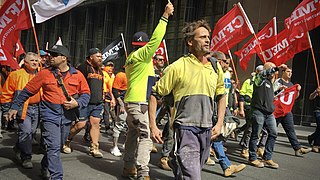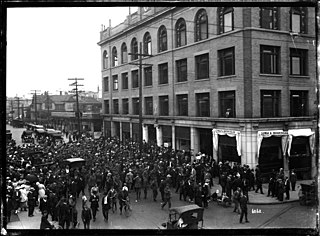Related Research Articles
Labour laws are those that mediate the relationship between workers, employing entities, trade unions and the government. Collective labour law relates to the tripartite relationship between employee, employer and union. Individual labour law concerns employees' rights at work also through the contract for work. Employment standards are social norms for the minimum socially acceptable conditions under which employees or contractors are allowed to work. Government agencies enforce labour law.
The Railway Labor Act is a United States federal law on US labor law that governs labor relations in the railroad and airline industries. The Act, enacted in 1926 and amended in 1934 and 1936, seeks to substitute bargaining, arbitration and mediation for strikes to resolve labor disputes. Its provisions were originally enforced under the Board of Mediation, but they were later enforced under a National Mediation Board.

The National Labor Relations Act of 1935 is a foundational statute of United States labor law that guarantees the right of private sector employees to organize into trade unions, engage in collective bargaining, and take collective action such as strikes. Central to the act was a ban on company unions. The act was written by Senator Robert F. Wagner, passed by the 74th United States Congress, and signed into law by President Franklin D. Roosevelt.

The Labor Management Relations Act of 1947, better known as the Taft–Hartley Act, is a United States federal law that restricts the activities and power of labor unions. It was enacted by the 80th United States Congress over the veto of President Harry S. Truman, becoming law on June 23, 1947.

Strike action, also called labor strike, labour strike, or simply strike, is a work stoppage, caused by the mass refusal of employees to work. A strike usually takes place in response to employee grievances. Strikes became common during the Industrial Revolution, when mass labor became important in factories and mines. In most countries, strike actions were quickly made illegal, as factory owners had far more power than workers. Most Western countries partially legalized striking in the late 19th or early 20th centuries.
Collective bargaining is a process of negotiation between employers and a group of employees aimed at agreements to regulate working salaries, working conditions, benefits, and other aspects of workers' compensation and rights for workers. The interests of the employees are commonly presented by representatives of a trade union to which the employees belong. The collective agreements reached by these negotiations usually set out wage scales, working hours, training, health and safety, overtime, grievance mechanisms, and rights to participate in workplace or company affairs.
In United States labor law, at-will employment is an employer's ability to dismiss an employee for any reason, and without warning, as long as the reason is not illegal. When an employee is acknowledged as being hired "at will", courts deny the employee any claim for loss resulting from the dismissal. The rule is justified by its proponents on the basis that an employee may be similarly entitled to leave their job without reason or warning. The practice is seen as unjust by those who view the employment relationship as characterized by inequality of bargaining power.
In labor law, a union shop, also known as a post-entry closed shop, is a form of a union security clause. Under this, the employer agrees to either only hire labor union members or to require that any new employees who are not already union members become members within a certain amount of time. Use of the union shop varies widely from nation to nation, depending on the level of protection given trade unions in general.

United States labor law sets the rights and duties for employees, labor unions, and employers in the United States. Labor law's basic aim is to remedy the "inequality of bargaining power" between employees and employers, especially employers "organized in the corporate or other forms of ownership association". Over the 20th century, federal law created minimum social and economic rights, and encouraged state laws to go beyond the minimum to favor employees. The Fair Labor Standards Act of 1938 requires a federal minimum wage, currently $7.25 but higher in 29 states and D.C., and discourages working weeks over 40 hours through time-and-a-half overtime pay. There is no federal law requiring paid holidays or paid family leave, and limited state laws. The Family and Medical Leave Act of 1993 creates a limited right to 12 weeks of unpaid leave in larger employers. There is no automatic right to an occupational pension beyond federally guaranteed social security, but the Employee Retirement Income Security Act of 1974 requires standards of prudent management and good governance if employers agree to provide pensions, health plans or other benefits. The Occupational Safety and Health Act of 1970 requires employees have a safe system of work.
The National Labor Relations Board, an agency within the United States government, was created in 1935 as part of the National Labor Relations Act. Among the NLRB's chief responsibilities is the holding of elections to permit employees to vote whether they wish to be represented by a particular labor union. Congress amended the Act in 1947 through the Taft–Hartley Act to give workers the ability to decertify an already recognized or certified union as well. This article describes, in a very summary manner, the procedures that the NLRB uses to hold such elections, as well as the circumstances in which a union may obtain the right to represent a group of employees without an election.

Union busting is a range of activities undertaken to disrupt or prevent the formation of trade unions or their attempts to grow their membership in a workplace.

The Civil Service Reform Act of 1978, (CSRA), reformed the civil service of the United States federal government, partly in response to the Watergate scandal. The Act abolished the U.S. Civil Service Commission and distributed its functions primarily among three new agencies: the Office of Personnel Management (OPM), the Merit Systems Protection Board (MSPB), and the Federal Labor Relations Authority (FLRA).

The Federal Labor Relations Authority (FLRA) is an independent agency of the United States government that governs labor relations between the federal government and its employees.
Worker centers are non-profit community-based mediating organizations that organize and provide support to communities of low wage workers who are not already members of a collective bargaining organization or have been legally excluded from coverage by U.S. labor laws. Many worker centers in the United States focus on immigrant and low-wage workers in sectors such as restaurant, construction, day labor and agriculture.

Labor relations is a field of study that can have different meanings depending on the context in which it is used. In an international context, it is a subfield of labor history that studies the human relations with regard to work – in its broadest sense – and how this connects to questions of social inequality. It explicitly encompasses unregulated, historical, and non-Western forms of labor. Here, labor relations define "for or with whom one works and under what rules. These rules determine the type of work, type and amount of remuneration, working hours, degrees of physical and psychological strain, as well as the degree of freedom and autonomy associated with the work."
The Blue Eagle at Work: Reclaiming Democratic Rights in the American Workplace is a legal treatise written by Charles J. Morris which analyzes collective bargaining under the National Labor Relations Act (NLRA), the federal statute governing most private sector labor relations in the United States. Published in 2005 by Cornell University Press, the text claims that the NLRA guarantees that employees under that Act have the right to bargain collectively through minority unions—but only on a members-only basis—in workplaces where there is not an established majority union, notwithstanding that the present practice and general understanding of the law is that only majority-union employees are entitled to engage in collective bargaining on an exclusivity basis. Contracts resulting from such minority-union bargaining would apply to union members only, not to other employees.
NLRB v. Mackay Radio & Telegraph Co., 304 U.S. 333 (1938), is a US labor law case of the US Supreme Court which held that workers who strike remain employees for the purposes of the National Labor Relations Act (NLRA). The Court granted the relief sought by the National Labor Relations Board, which sought to have the workers reinstated by the employer. However, the decision is much better known today for its obiter dicta in which the Court said that an employer may hire strikebreakers and is not bound to discharge any of them if or when the strike ends.
Communications Workers of America v. Beck, 487 U.S. 735 (1988), is a decision by the United States Supreme Court which held that, in a union security agreement, unions are authorized by statute to collect from non-members only those fees and dues necessary to perform its duties as a collective bargaining representative. The rights identified by the Court in Communications Workers of America v. Beck have since come to be known as "Beck rights," and defining what Beck rights are and how a union must fulfill its duties regarding them is an active area of modern United States labor law.
Golden State Transit Corp v City of Los Angeles, 475 U.S. 608 (1986), is a US labor law case, concerning the scope of federal preemption against state law for labor rights.
Electromation Inc 309 NLRB No 163 (1992) is a US labor law case related to employer domination of labor organizations.
References
- ↑ "A Short History of the Statute [FSLMRS]". FLRA (Federal Labor Relations Authority). Retrieved 9 April 2018.
- ↑ Ingraham and Rosenbloom, eds. (1992). The Promise and Paradox of Civil Service Reform. Pittsburgh Press. pp. 95 (quoting Carolyn Ban, "Implementing Civil Service Reform" (1984) at 219).CS1 maint: extra text: authors list (link)
- ↑ "The Statute: § 7101. Findings and purpose" . Retrieved 9 April 2018.